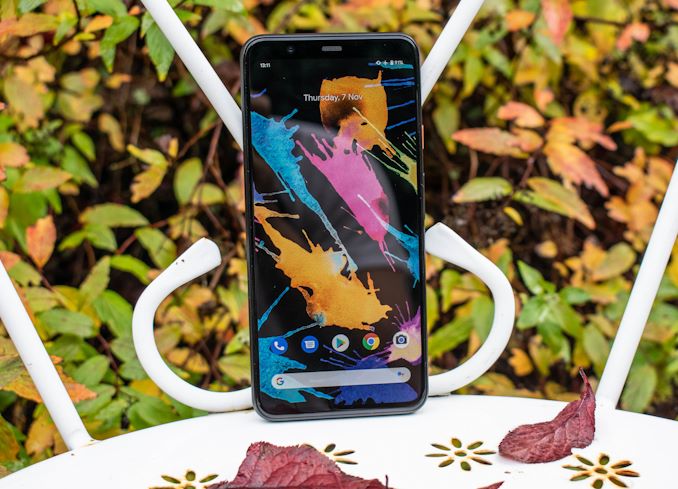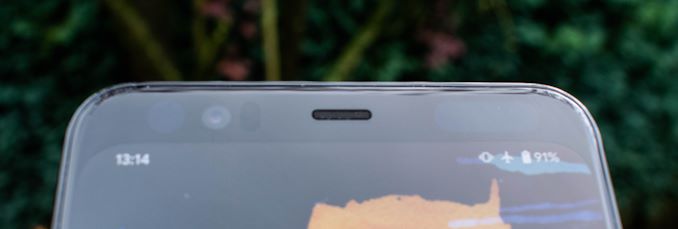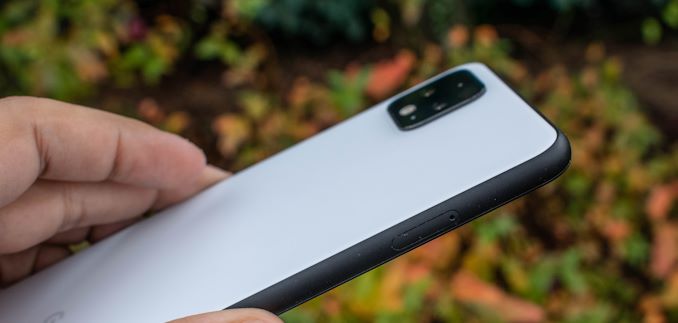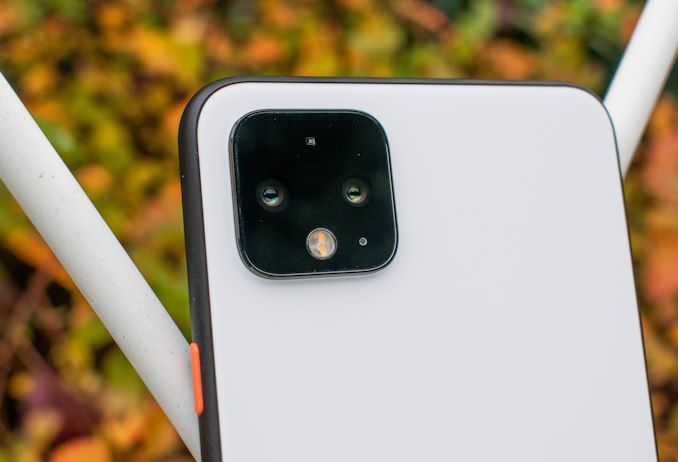The Google Pixel 4 XL Review: Stuck In The Past In 2019
by Andrei Frumusanu on November 8, 2019 11:30 AM EST- Posted in
- Mobile
- Smartphones
- Pixel 4
- Pixel 4 XL

Amongst the last big smartphone releases of 2019 is Google’s Pixel 4 series. Google’s own flagship devices come late in the generational product cycle whose timing is mostly dictated by the SoC release schedule – it’s always hard to be able to make a case for your product knowing in a few months’ time we’ll be seeing a barrage of new competing products raising the bar again. Google’s forte in this regard is that it promises to augment its products with features beyond what the hardware can provide, yet in a sense, the Pixel 4’s biggest improvements (and weaknesses) this year are actually mostly related to its hardware.
The new Pixel 4 is again a camera centric phone – it’s the topic that Google talked about the most and dedicated the most time to during its launch event in New York. The Pixel 4 adds for the first time a second camera module that acts as a telephoto unit, and also promises to have improved the capture quality on the new main camera. Whilst Google has a reputation for having good cameras, the Pixel 4 this year faces incredible competition as essentially every other vendor this year has launched devices with triple cameras and have stepped up in terms of their computational photography capabilities.
Other big features of the Pixel 4 include a new 90Hz capable display panel that allows for a new ultra-smooth device experience, a feature that’s still quite rare amongst flagship devices this year, but quickly catching up with many vendors. Another big change for the Pixel 4 is the dropping of the fingerprint sensor in favour for a new full-blown face unlock feature. This latter feature is augmented by another novelty of the Pixel 4: A radar sensor that’s able to detect movements and gestures pointed at the phone.
We’ll be putting the new Pixel 4 XL through our test benches and determine if Google has managed to create a compelling product worth your money.
| Google Pixel 4 and Pixel 4 XL | ||||
| AnandTech | Pixel 4 |
Pixel 4 XL (Reviewed) |
||
| SoC | Snapdragon 855 1 x 2.84 GHz Kryo 485 3 x 2.42 GHz Kryo 485 4 x 1.78 GHz Kryo 485 Adreno 640 Graphics |
|||
| DRAM | 6 GB LPDDR4X | |||
| Storage | 64 GB or 128 GB UFS | |||
| Display | 5.7" POLED 2280 x 1080 (19:9) 90 Hz |
6.3" AMOLED 3040 x 1440 (19:9) 90 Hz |
||
| Size | Height | 147.1 mm | 160.4 mm | |
| Width | 68.8 mm | 75.1 mm | ||
| Depth | 8.2 mm | 8.2 mm | ||
| Weight | 162 grams | 193 grams | ||
| Battery Capacity | 2800 mAh | 3700 mAh | ||
| Charging | 18 W Wired Quick Charge 2.0 Qi Wireless Charging |
|||
| Rear Cameras | ||||
| Main | 12.2MP 1.4µm Dual Pixel PDAF f/1.7 1/2.55" sensor with OIS |
|||
| Telephoto | 16 MP f/2.4 1.0 micron PDAF, OIS, 1.7x Optical Zoom |
|||
| Wide | - | |||
| Extra | - | |||
| Front Camera | 8MP 1.12µm f/2.0 + ToF 3D Camera |
|||
| I/O | USB-C 3.1 (5 Gbps) No 3.5mm headphone jack |
|||
| Wireless (local) | 802.11ac Wave 2 Wi-Fi Bluetooth 5.0 LE + NFC |
|||
| Cellular | UE Category 18 (DL) / Category 12 (UL) 1200 Mbit/s DL (5xCA 2x2 MIMO) 150 Mbit/s UL |
|||
| Other Features | Stereo Speakers IP68 Android 10 Project Soli Radar Motion Sensng No fingerprint sensor, face ID only |
|||
| Dual-SIM | 1x nanoSIM + 1 x eSIM | |||
| Colors | White Black Orange |
|||
| Launch Price | €749 / $799 for 64GB $899 for 128GB |
€899 / $899 for 64 GB $999 for 128 GB |
||
As noted, the internal hardware of the Pixel 4 XL isn’t all particularly exciting at this point in time. The Snapdragon 855 is the same SoC that we’ve seen in devices launched in February and March. Google could have opted to use the slightly faster and better binned Snapdragon 855+ this year, but for whatever reason it didn’t make it. That being said, Google is known to be able to create amongst the best implementations of a given SoC, so we’re expecting a very fast device experience.
One big criticism that the Pixel 3 suffered from last year and that the Pixel 4 series partly addresses is the RAM. Android is quite memory hungry and Google has now updated the line-up from 4GB to 6GB which should help in keeping more applications alive. It’s still a step below what other vendors offer this year as 8 and 12GB variants have become relatively standard in the high-end.
One aspect that isn’t high-end at all is Google’s choice to go with 64GB of storage in the base models. This is a bit painful to see as more and more vendors go with 128GB as the minimum. The up-sell to 128GB costs $100 which is even more than Apple’s $50 premium for the same upgrade, putting the Pixel 4 in an even more awkward situation.
Key to the Pixel 4’s are the new display panels. The Pixel 4 XL goes for a more elongated 6.3” 3040 x 1440 resolution screen, resulting in a 19:9 aspect ratio, whilst the regular Pixel 4 remains at the smaller 2280 x 1080 for the smaller 5.7” form-factor. The big news here is the inclusion of 90Hz refresh rates. High refresh displays in mobile have really made an impact this year, with the OnePlus 7 Pro particularly making a lasting impression. Google’s implementation is slightly more subdued as it’s adaptive refresh rate switching feature between 60 and 90Hz is still a bit quirky – however one can force the devices to be in 90Hz mode all the time, although it comes at a cost in power consumption.
Google promises that this year they’ve paid a lot more attention to the colour calibration of their screens. In the past we’ve seen some major oddities in terms of the target gamma that Google had employed and a few miscalibration issues in regards to the average picture level scaling of the screen. This year the Pixel displays are again dual-sourced between LG and Samsung. The regular Pixel 4 receives an LG panel, whilst the Pixel 4 XL we tested today employs a Samsung unit.
One aspect of the phone’s new designs is that they’re not trying to be that extravagant. Both have larger display bezels on the top (“foreheads”) instead of going for cut-outs or notches. Good riddance to monstrosity that was the double-height notch of the Pixel 3 XL.
Google needed to use a forehead design this year simply because the Pixel 4s are packed to the brim with sensors. Whilst the phones see a downgrade from dual front-facing cameras to a single unit this year, we see the addition of an IR camera, a flood illuminator and a dot projector, the usual array of hardware we’ve seen for the more advanced facial unlock implementations out there.
On the right side of the earpiece speaker, we see another big novelty: Project Soli. In essence this is a miniature radar emitter and receiver and is at the heart of Google’s take on motion gestures. I’ll be blunt here: the feature is very much a gimmick that serves very little practical purpose. We’ve seen gestures attempted in the past by vendors such as Samsung and LG, and they never managed to win any kind of adoption. Google’s implementation work “ok” in the few tasks that are currently available such as skipping between music tracks, but these are just coarse gestures that aren’t any different than what we’ve seen from other vendors. The one big actual practical advantage of the system is that it aids face unlocking: the phone is able to detect you reaching for it and is able to wake up sooner in order to fire up the face unlocking sensors and cameras – reducing the reaction time and unlock time, which is pretty good.
The back design of the phone is relatively simple as we see a glass backplate with only the camera square as the dominating feature. The back glass on the orange and white models this year is fully matte with an etched finish, similar to the one we’ve seen last year on the Pixel 3. The black unit however for some reason is a glossy finish which means it’ll be more prone to smudges; I would have hoped Google had went with the matte finish across all colours.
The frame of the Pixel 4 is very odd in terms of feeling. The frame is made of aluminium; however, it’s coated in a new special material. It doesn’t feel like metal anymore but it’s also not plastic feeling. Personally, I like it because it’s matte and gives good grip on the phone. What I didn’t like is the new ergonomics of the frame. Google this year no longer tappers/rounds off the edges towards the back of the phone, and what this results in is that the phone feels thicker than it is – the Pixel 3 had a much better in-hand feel in this regard.
Talking about thickness, it’s at 8.2mm for both devices. Oddly enough even though it’s at the higher end of the thickness spectrum, Google wasn’t able to employ quite as big batteries as one might expect. The Pixel 4 XL comes with a 3700mAh battery, which whilst still around 10-20% smaller than what we see from the competition, is still relatively adequate. The smaller Pixel 4 however only has a 2800mAh unit, which is not only quite far from what we see in competing devices of the same form-factor, but also an actual downgrade from the Pixel 3 last year. It’s really unfortunate we weren’t able to get the regular Pixel 4 for testing as I think the battery life is going to be especially problematic for that variant of the phone.
The camera “square” for the Pixel 4 is a bit of an odd design choice, simply because it’s really only housing two camera modules, whilst the square/circle design of other vendors was introduced because they needed to house three or more cameras. It’s a practical design in the Pixel 4, but feels a bit bare compared to Apple or Huawei’s implementations.
The main camera of the Pixel 4 remains similar to its predecessors in specification: It’s a 12.2MP sensor with 1.4µm pixels and Dual Pixel PDAF, but it’s not the same sensor as on the Pixel 3. The newer unit promises to have better noise characteristics and it’ll be able to perform better in low-light situations and also offering more dynamic range in daylight. The optics have been slightly improved as the aperture is upgraded from f/1.8 to f/1.7, allowing for more light.
The Pixel series’ first secondary rear camera module is a telephoto unit. Here Google has chosen a 16MP sensor with 1µm pixels and an f/2.4 aperture lens. The optical magnification compared to the main sensor isn’t 2x as what we’d expect, but more precisely 1.7x. It’s an odd combination what we hadn’t seen before and we’ll investigate the benefits and drawbacks later in the camera section.
There’s been a bit of a unanimous consent amongst media and users that Google’s choice to go with a telephoto lens instead of an ultra-wide-angle module as the second camera was a mistake, and I’m of the same opinion. 2019 saw essentially every single vendor adopt UWA modules in their cameras, not only because it’s in vogue, but because it’s a more worthwhile camera experience than a telephoto module.
Google claims new HDR+ and Night Sight algorithms, and the computational photography aspect of the Pixel 4 is augmented by a new accompanying processing chip called the Pixel Neural Core which offloads computations from the SoC.
Finally, the last big change that’s notable for the Pixel 4 is that Google has dropped its dual-front facing speaker design. The Pixel 4 now instead uses a regular earpiece & bottom firing stereo speaker setup. It’s adequate enough, but doesn’t match the stereo balance and quality of Samsung’s Galaxy series or Apple’s iPhones.
Also related to the audio, the Pixel 4 doesn’t ship with any kind of headphones or even a 3.5mm adapter so you’ll have to have compatible USB-C units at hand or buy them extra (I really do not recommend the Pixel USB-C units). Or you can also be a schmuck and chose to spend a heavy premium getting wireless earbuds – but again, not the new Pixel Buds as they won’t even be available till sometime in early 2020.
Overall, the Pixel 4 XL’s hardware seems rather underwhelming, but that’s been the case of previous generation Pixel devices as well. What matters, is how the new phone performs and if the new cameras are up to the task. Let’s start with performance.

















159 Comments
View All Comments
Andrei Frumusanu - Friday, November 8, 2019 - link
It goes up to 600 nits in HDR video content, I don't currently have a good methodology to measure that.s.yu - Friday, November 8, 2019 - link
Daylight:I now realize that the crushed black issue is probably not really an issue, it's an attempt to hide the raised noise floor resulting from stacking underexposed shots. Take the poorly lit loading area of that building in sample 3 for example, Pixel 3 displays a similar depth into the shadows to iP11P and S10+, but Pixel 4 goes further at the cost of a lot more noise, while Mate30P simply has more shadow DR because of the larger sensor and that it doensn't use such a stack.
Also I don't believe the difference in shadow mapping(darker, but far from pitch black leaves, vs. lighter leaves) is evidence of raised DR. It's only raised DR if deeper shadows are revealed at the cost of no more noise, or if the same shadow is now less noisy, but neither is true as evident in the foreground shadow of sample 4, Pixel 4's shadow is, as I noticed at GSMA without even a direct comparison, more noisy than Pixel 3's. Not only noisy but flat-looking, an overdone HDR effect. It's so bad there's blotching, under the roof of the building to the left in sample 4. The costs seem to notably outweigh the gains, or Pixel 4 used an even faster shutter for this specific shot to recover more highlight, resulting in worse shadows. In this shot iP11P's hybrid bracketing approach utilizing longer exposure time for some of the frames shows its strength and delivers the most solid shadows among the different stacking approaches. So if Apple were to lift shadows to the same extent as Pixel 4 then we might have been able to see deeper shadows back in sample 3.
Come to think of it, Pixel 4's noisy shadows were even notable in the official samples leaked before launch. I thought it was due to pre-retail firmware but I was too optimistic.
Look's like Apple's is the best overall but Pixel 3 has the most stable detail retention. Samsung still lacks detail as it has been for quite some time but at least DR wise it generally matches Apple. Huawei's latest Mate30P greatly dials down both sharpening and NR resulting in a surprising number of keepers, only sometimes sharpening would seem too low yielding in what's now not waxyness but a thin haziness, or maybe the sharpening threshold is too high.
Low light:
In the first sample Pixel 4 obviously added more NR, not a good choice as the noise level of Pixel 3 in this image is completely manageable, more NR only smeared the output. iP11P seems between the two Pixels in a number of metrics. Huawei's night mode apart from somewhat aggregated texture intensely suppresses highlights at the cost of various artifacts present since P20P, can't say I ever liked it.
Sample 2: Again Pixel 4 is rather taking the shove the noise floor in your face approach rather than actually yielding more shadow DR, just look at the blotchy sky compared to its predecessor, however it's able to better recover highlights from the office windows.
In the castle sample Pixel 4 definitely does something right, it's not only much cleaner but the blotchy sky is gone. Also I suspect less falloff from the new lens, which yields better corners. Mate30P's technically very large UWA is better than the Samsung's tiny sensor yet a lot worse than the main, perplexing as this sensor's output stacked should still be competitive, also the fact that Mate30P's night mode is only ~21mm equiv. which is halfway between the other two UWA(~12-13) and the mains, in fact leaning toward the FoV of the mains is another issue to consider.
Second last sample: Apple's algorithm of being able to extract data from relatively sufficient light but complete inability to work with deeper shadows in low light reminds me of the Kandao RAW+ I tried out recently, it's similar in that decent data from a single frame could be greatly improved when stacked, but really poor data from a single frame is left untouched no matter how many frames you stack, which could result in very clean highlights yet completely useless shadows at a certain noise level.
Andrei Frumusanu - Friday, November 8, 2019 - link
Thanks for your input, great post.s.yu - Saturday, November 9, 2019 - link
:)s.yu - Saturday, November 9, 2019 - link
Thanks for the great samples, your hands seem even steadier than before and the framing is far more consistent than what I expect of handheld comparisons.hoodlum90 - Friday, November 8, 2019 - link
Great analysis and I agree with much of your comments. Each of these cameras provide a slightly different look with different emphasis placed on Noise Reduction / Detail, White Balance, shadows, highlights, etc. I think a lot of it comes down to your individual preference.Personally I do not like how Samsung applies a lot of noise reduction which impacts detail. But I know there are many that prefer this.approach.
The Night scenes seam to provide the greater variance. One example is the Castle where the S10, Pixel and iPhone provide similar renderings with differences in white balance, noise reduction and detail. The P30 Pro seems to take a different approach that I do not like. In this scene the P30 Pro provided a more flat lighting that seems unrealistic. The background trees are the brighter green and the sky has lost all cloud detail. This reminds me of the HDR from the previous gen iPhones that also did not look realistic.
s.yu - Saturday, November 9, 2019 - link
"Personally I do not like how Samsung applies a lot of noise reduction which impacts detail."Yeah, me neither. What's even more worrying was that the Note10 series had that up a notch compared to the S10 series which was at least largely on par with Note9 and S9. There's hope for a different turn if S11 uses that new HMX, or at least 27MP would still match the pixel downsampled to 12MP, but there's also speculation that the flagship won't use the best and largest sensor(seeing how Mi Note 10 is close to 1cm thick it makes sense).
"The Night scenes... that I do not like."
Yeah, me neither. :) It's too flat, not only from Andrei's review but also from GSMA's review that came out faster with far fewer samples. In some instances P30P/Mate30P would suppress highlights so much that a night scene is turned to a dusk scene as street lamps look dim and weak and cast light not significantly brighter than the surroundings. It's completely overdone and it's a mistake I wouldn't have made 10 years ago when I just started to post process my photos.
Also if you look closely at the trees I would suspect that it's artificially colored. RYYB should distinguish green poorly(it leaks longer wavelength through by design after all) and the green looks mushy with a fake-looking color tone leaning towards cyan. I wouldn't be surprised if this color was filled by the so-called "AI" as it might have recognized trees when the camera failed to determine the actual color in that area, while it's not precise enough for a more convincing fill.
hoodlum90 - Friday, November 8, 2019 - link
There is a little trick to force the Night Mode option on the iPhone 11. The iPhone seems to determine the mode based on what it is focusing on. If you manually focus on the one of the darker area in the night photos where Night Mode was not an option, then it would show up as an option. You just need to remember to manually lower exposure as the scene may end up brighter than expected. Something similar can be done to enforce the "deep fusion" mode in certain instances although that is more difficult to determine as the iPhone doesn't tell you when this mode is used.This seems to be a quirk that Apple can easily fix but for now needs to be worked around manually.
Spencer1 - Sunday, November 17, 2019 - link
Thanks for this nugget. I’ll try it when I get my unit.Hulk - Friday, November 8, 2019 - link
I only care about the following things when checking out a phone.How does it feel in my hand?
How is the display?
How long does the battery last?
How fast does the camera open?
How good is the camera?
Honestly all high end phones are pretty good on these points. I have a Pixel 2 because I'm a Google Fi subscriber. I'll pass on the Pixel 4. I don't see any significant improvements on the points I listed above.